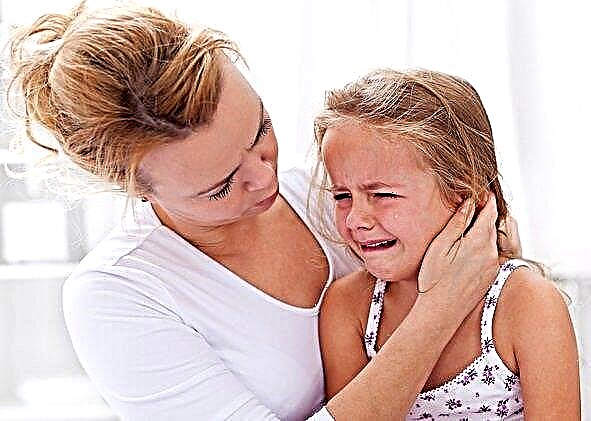When a child cannot sleep well and stay awake due to cold symptoms (cough, runny nose, fever, etc.), parents try to relieve his condition as soon as possible. Many of them are widely used for this purpose inhaler. But is it always allowed to inhale children? Do they have age restrictions or side effects? Can inhalation be done at a temperature? When is it generally recommended?
Is inhalation allowed for children at a temperature
This question is often asked by parents when their child has fever, coughs or "snotty." Many of them know that when any respiratory disease occurs, the body actively fights against the causative agent of the disease, which contributes to a rise in temperature during this period.
These changes can be a serious burden for the baby's body. And any thermal effect from the outside (for example, hot foot baths, wrapping, etc.) can threaten his life, so parents doubt whether it is allowed to inhale at a temperature or not?
The pharmacy network has a large selection of inhalers, but many instructions for the devices state that it is forbidden to use them at a body temperature of more than 37.5 ° C. Despite this, there are indications in which inhalations are simply vital.
The rise in the baby's body temperature to very high numbers indicates the inability of the body to fight the infection on its own.

When inhalation is prohibited
Inhalation is prohibited in cases of:
- tendency to nosebleeds;
- cardiovascular diseases or the likelihood of their occurrence (these include: severe heart defects, arrhythmias, heart attacks, strokes, heart failure);
- purulent sore throat, otitis media, sinusitis in a child;
- pneumothorax, bullosa pulmonary emphysema;
- polyps in the nose;
- pulmonary bleeding.
When inhalation is allowed
When the temperature rises above 37.5 ° C and there is an urgent need for inhalation, it is allowed to carry it out, but only with a nebulizer.
Inhalation with hot steam when the temperature rises above 37.5 ° C is prohibited, as this can contribute to an even greater rise.
Inhalation at a temperature is allowed if the baby has:
- obstructive bronchitis;
- laryngitis;
- laryngotracheitis;
- bronchial asthma and other diseases, accompanied by a sharp narrowing of the airways.
An increase in body temperature in these cases is not a contraindication for inhalation therapy, since there is a high risk of suffocation.
Why the temperature is not compatible with some types of inhalations
Steam inhalation during hyperthermia is prohibited due to the fact that when inhaling hot vapors, overheating of the body and even convulsions can occur. The risk group includes children with a tendency to develop febrile seizures.
Nebulizer and other types of inhalation
There are several ways to carry out inhalation:
- "Grandmother's or folk method" - these are inhalation over potatoes, herbal decoctions, essential oils, steam, hot water. "+" Of this method of inhalation: the mucous membranes are moistened and the tissues of the respiratory tract are warmed, their irritation is eliminated, blood circulation improves, and leukocyte and other cells of the immune system in the focus of inflammation are activated (which contribute to recovery). This method is effective if your child has a runny nose and sore throat. "-" of this method: it is not effective for diseases of the bronchi and lungs (since large drops of steam do not penetrate into these organs) and is prohibited when the temperature rises above 37.5 ° C;
- using a glass inhaler. This method is based on inhalations with various essential oils. Its "+": inexpensive, easy to operate, compact. "-" of this device: fragile, and may also cause an allergic reaction to essential oils;
- using a steam inhaler. Its effect is achieved due to the fact that thermal evaporation of drug solutions occurs. Inhalation of warm steam softens the mucous membrane of the upper respiratory tract and enhances the therapeutic effect of the drug. Its "+": inexpensive, can also be used for cosmetic purposes, easy to handle, it is allowed to use it for inhalation with medicinal plants and oil solutions. "-" inhaler: it is forbidden to use it for infections in the lower respiratory tract and small children; some medicinal substances lose their effectiveness after heating;
- using an ultrasonic inhaler. Medicines are sprayed by ultrasonic vibrations. Medicines become a cool aerosol and enter the upper and lower respiratory tract. The price of the device depends on the design, configuration and functions. Its "+": functional, compact, reliable, has a low noise level, works both on batteries and from the mains, it is allowed for use by children. "-" of this inhaler are: expensive, you can not use oil solutions and some drugs, because they are destroyed by ultrasound (for example, antibacterial drugs, mucolytics);
- using a compressor or jet inhaler (nebulizer). Its effect is achieved by spraying a strong jet of air. "+" Of the device: is universal for any medications; creates an aerosol suspension with very small particle sizes due to which it spreads into all respiratory tract; compact, comfortable and lightweight (weighs less than a kilogram); there is no need to buy additional accessories for it. His "-": expensive and noisy.
The most advanced is the compressor inhaler. It combines the following parameters: good quality, functionality, and also relatively affordable in price.

When inhalation is recommended
If a child or an adult has a runny nose and / or cough, the doctor may prescribe inhalation with sodium chloride or other drugs.
Indications for the appointment of inhalation:
- runny nose - it is a constant "companion" of allergic and colds. It is characterized by swelling, nasal congestion, and nasal discharge;
- cough. With different types of cough and with various diseases, inhalations contribute to a speedy recovery. Thanks to them, mucous membranes are moistened, mucous discharge is intensively formed, edema and inflammation are reduced, a dry cough turns into a wet one.
Inhalation is allowed if:
- acute and chronic bronchitis;
- bronchial asthma;
- inflammation of the lungs (during the recovery period);
- cystic fibrosis;
- bronchiectasis;
- ARVI (not in the acute period);
- laryngitis;
- tracheitis, etc.

Inhalation medications
The most widespread are alkaline inhalations with mineral water and sodium chloride (saline). They moisturize the mucous membrane and thin the thick mucus.
Today in pharmacies there are a huge number of medicines that are also used for inhalation.
They are referred to:
- antiseptics (Miramistin, Furacilin, etc.);
- antibiotics (Tobramycin, Gentamicin, etc.);
- anesthetics (lidocaine);
- immunomodulators (Interferon, Derinat);
- hormonal drugs (Dexamethasone, Pulmicort, etc.);
- mucolytics (Ambroxol, Lazolvan, Acetylcysteine, etc.);
- vasoconstrictor drugs (Naphthyzin, Adrenaline);
- combined action drugs (Berodual, Fenoterol);
- phytopreparations (Chlorfillipt, Rotokan).
It should be noted that this is not the entire list of drugs that are used for inhalation.
All medicinal substances must be diluted with sodium chloride (water cannot be used for this purpose)!
It is important to note that only a doctor should determine the dosage and the need for a particular drug!

Herbal medicine in medical inhalations
It is not recommended to use herbal infusions made "with one's own hands", as well as aromatic oils and oil solutions. Because when particulate matter enters the lungs, it can cause inflammation, which can manifest as aseptic pneumonia.
For inhalation, it is better to purchase ready-made preparations in the pharmacy in the form of: Tonsilgon, Chlorfillipt, calendula and propolis tinctures.
Children of what age can inhalation
This question worries many parents due to the fact that, unfortunately, colds occur even in newborn children. But a pleasant fact is that today there is such a device as a nebulizer, thanks to which liquid molecules are split into aerosols (even a newborn child can breathe with them).
Inhalation with a nebulizer is allowed for babies from the moment of birth, but their implementation must be monitored by a doctor in a hospital!
Is inhalation allowed for pregnant women
Inhalation is allowed for pregnant women, but it is better to perform them with the help of a nebulizer, due to the fact that this method is more effective and safe. Many medicines act locally and, therefore, are harmless to the baby. But you should know that it is forbidden to carry out inhalations using essential oils and medicinal plants, as they can contribute to allergies and swelling of the mucous membranes.
Inhalations for pregnant women should be prescribed exclusively by a doctor!
Whether to expect adverse reactions during inhalation at a temperature
If inhalation with a nebulizer is carried out correctly, adverse reactions almost never occur. But it is important to note that holding it over a steam inhaler or steam during hyperthermia is prohibited, as this is fraught with convulsions and very high fever.
Tips for parents
Before you inhale, you need to know the following.
- Indications for inhalation have a limited list of diseases, so any cough and runny nose should not be treated using this method.
- Before carrying out any inhalation, be sure to consult a doctor.
- Inhalation at a body temperature of more than 37.5 ° C is not prohibited (if indicated and a nebulizer is available).
- This procedure is allowed from birth.
Conclusion
Some parents, before carrying out any procedure for their child, will “ask the pediatrician 300 times” what to do and how, while others do everything at their own discretion, without consulting or asking a specialist.
So, inhalations are a serious medical procedure and their unauthorized appointment and conduct, both at elevated temperatures and without it, can contribute to serious complications. Therefore, do not self-medicate! Only the doctor should individually select the drug and its dosage. Be healthy! Take care of your children!
Article rating:



